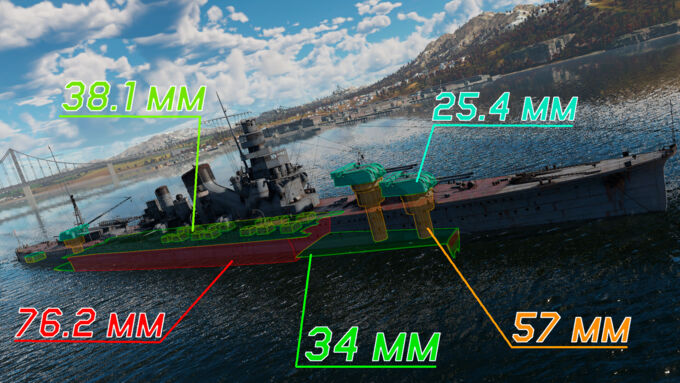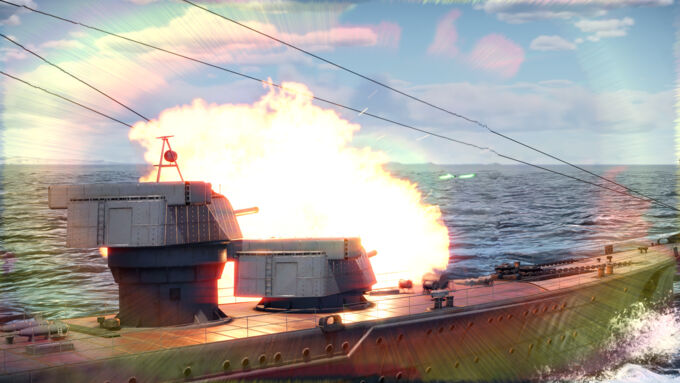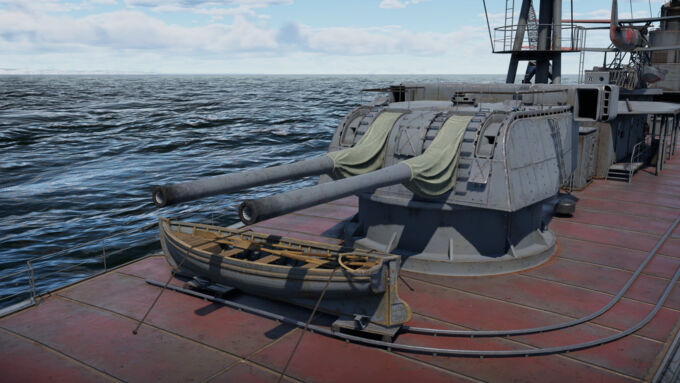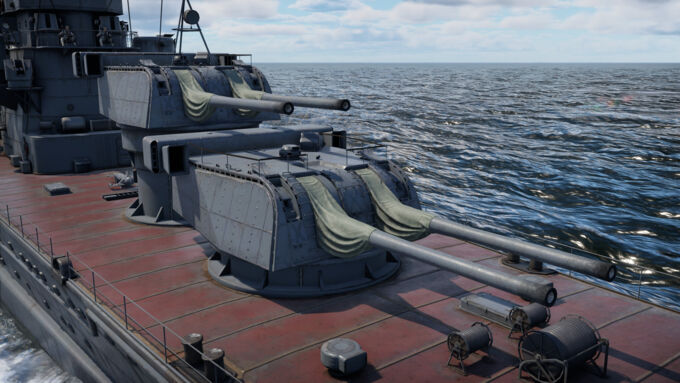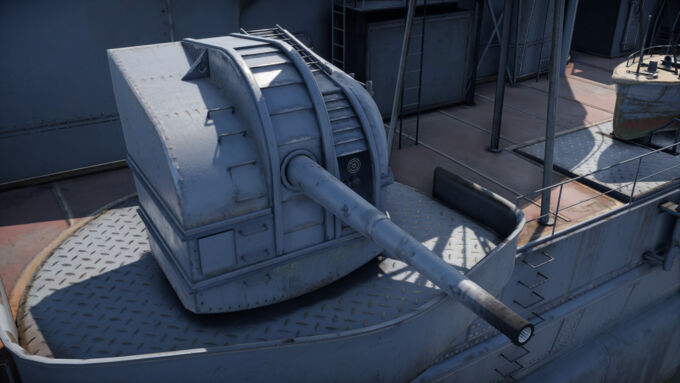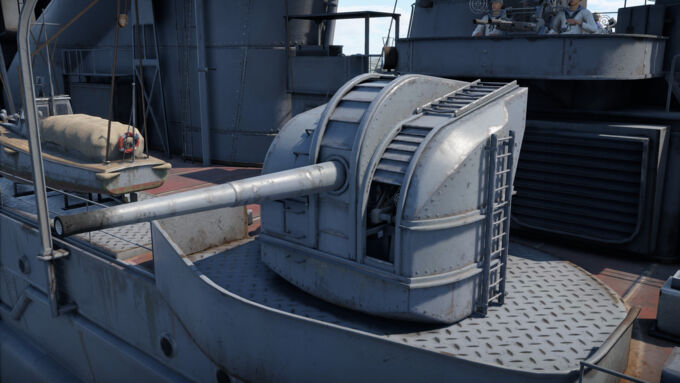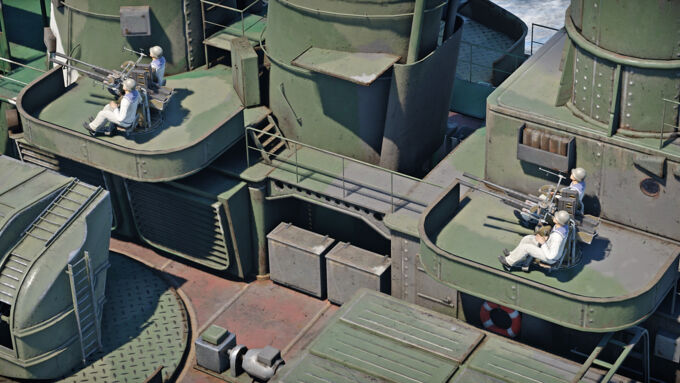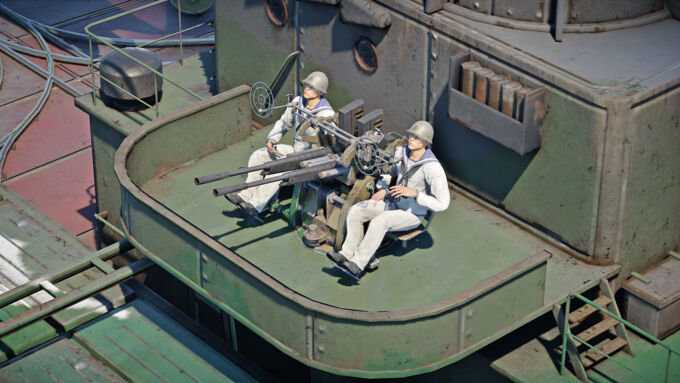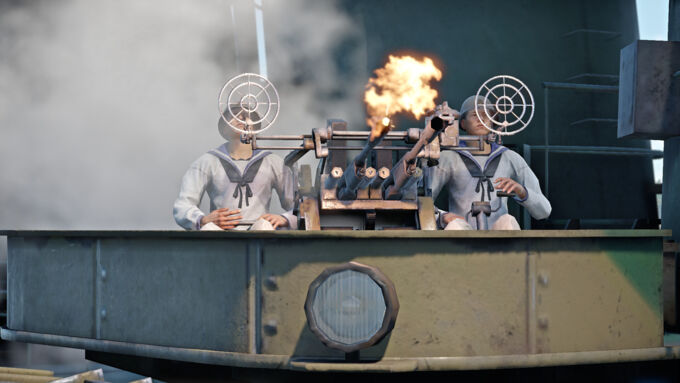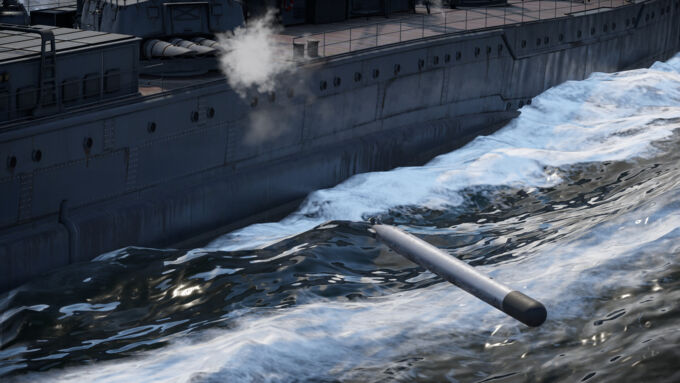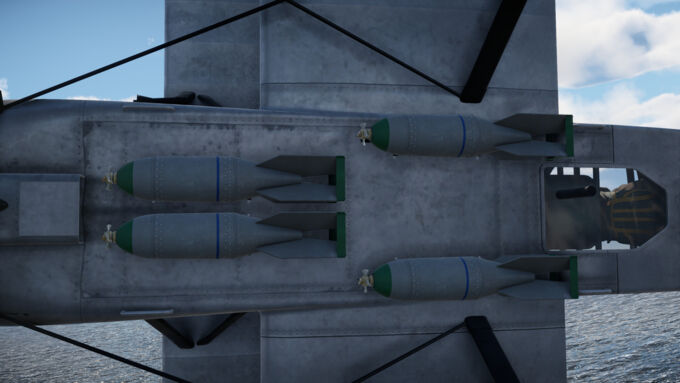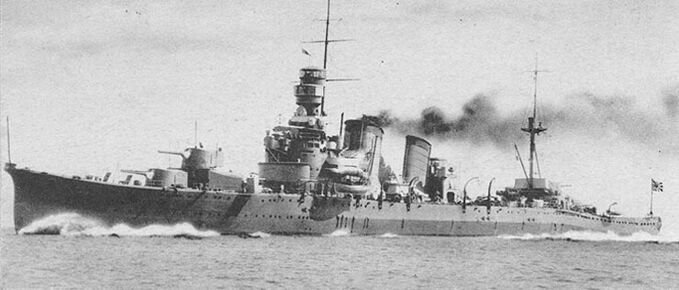IJN Furutaka (古鷹, named after Mount Furutaka in Etajima, Hiroshima) was the first heavy cruiser built for the IJN, but at the time of commissioning, she was designated as a “first-class cruiser”, as the term “heavy cruiser” was defined later. Originally built as a “fast scout cruiser”, she combines very good mobility with excellent firepower brought by the modified Type 3 №2 main battery guns. This is further enhanced by her very powerful torpedo armament, but at the same time, she is an attractive target for enemy aircraft, as her anti-aircraft and secondary armament are among the worst found on cruisers.
| Advantages | Disadvantages |
| Excellent mobility | Weak secondary armament |
| Powerful main battery | Weak anti-aircraft armament |
| Good torpedo armament | Low protection of main battery turrets |
Armor and survivability
The cruiser’s 76.2 mm thick main belt covers the boiler rooms from the sides, which is protected above by a deck of thickness from 31.75 mm to 35 mm, and the stern and bow are enclosed by 76.2 mm thick armored bulkheads. Also on the sides, above the armor deck, are the coal bunkers, which give minor protection equivalent to 10 mm of armor. The main battery magazines are not protected from the sides, but they are below the waterline and also protected from the front by a transverse of thickness from 38 to 63.5 mm, as well as covered from above by a 34 mm thick armored deck. There is no protection of the bridge.
The cruiser is characterized by a very good survivability, it is able to emerge victorious from a duel with almost any possible opponent from among its any direct peers. Despite the fact that the crew is located inside the armored citadel, it’s worth noting that it dwindles rather quickly, mostly because of poorly protected gun mounts, both main and secondary armament. However, IJN Furutaka can escape from under crossfire quite easily relying on its good mobility.
Mobility
The cruiser’s mobility is one of the best across the heavy cruisers. In their aggregate, it surpasses almost all of its opponents. A speed of 71 km/h (38 knots) forward and 23 km/h (12 knots) astern in AB, and 61 km/h (33 knots) forward and 20 km/h (10 knots) astern in RB, which is slightly above the class average. In particular, the cruiser outperforms all of her British counterparts — cruisers of the County and York classes, as well as the American New Orleans class, also very similar with Italian Zara class (faster forward, slower astern), but is inferior to her relative Aoba. IJN Furutaka is also very easy to turn and very fast to gain speed, which also distinguishes it from its opponents for the better.
Armament
Main battery
The main caliber is represented by three Type E2 gun mounts with dual 203 mm Type 3 No. 2 guns. The guns have excellent accuracy and rate of fire — one shot every 12 seconds with an ace-level crew.
The guns have three types of shells to choose from:
- Armor-piercing high explosive with ballistic cap shell — 835 m/s, 125.85 kg/3.1 kg Type 91 explosive (TNT equivalent of 3.25 kg), armor penetration — 362 mm @ 1000 m, 321 mm @ 2.5 km, 263 mm @ 5 km;
- High-explosive fragmentation shell — 835 m/s, 125.4 kg/8.16 kg Type 91 explosive (TNT equivalent 8.65 kg), armor penetration — 61 mm at all ranges;
- High-explosive with time fuze — 835 m/s, 125.4 kg/8.16 kg of Type 91 explosive (TNT equivalent of 8.65 kg), armor penetration — 61 mm at all ranges.
The armor-piercing shell is an excellent choice as the main projectile — despite the relatively small amount of explosive filler, the projectile does serious damage, and its penetration ability is pretty good to fight its possible opponents. It is also better to have some amount of high-explosive shells — they have good damage, but have mediocre effectiveness against armored targets. There is no point in taking HE-TF shells — the turrets have a low horizontal guidance speed, which will not allow you to use these shells against planes.
Secondary armament
The secondary armament is represented by four single-gun Type B2 shielded mounts with 120 mm/45 Type 10 guns.
The gun has two projectiles:
- High-explosive fragmentation shell — 850 m/s, 20.33 kg/1.86 kg Type 91 explosive (TNT equivalent 1.95 kg), armor penetration — 24 mm at all ranges;
- High-explosive with time fuze — similar characteristics.
The problem with secondary armament guns is mainly that there are not enough of them. Often the guns do not create the necessary density of fire, while also lacking in accuracy. However, this battery can shoot down a bomber or strike aircraft flying at medium altitude before it gets into a bombing position, as these guns have very good muzzle velocity, but the very small number of them is still a problem.
Anti-aircraft armament
The air defense battery is marginal at best, being represented only by:
- Four twin Type 96 25 mm automatic guns located around the stern funnel;
- Two twin 13.2 mm Type 93 machine guns located forward of the bridge navigation platform.
The air defense composition is frankly insufficient, given the low effectiveness of the Type 96 machine guns, but this armament is enough to repel an attack by a single strike aircraft or fighter-bomber. In this case, it is worth noting that such a battery is better than no battery at all.
Additional armament
Traditionally for Japanese cruisers, IJN Furutaka also has a torpedo armament — two four-tube 610 mm torpedo tubes with full reload (16) of Type 93 Mod 2 torpedoes, which are famous “Long Lance”. Unlike in most cruisers, torpedoes are a capable offensive option rather than just a last-resort. IJN Furutaka has no modification for torpedo range (like other Japanese ships with these torpedoes), but it is not needed — Type 93 Mod 2 torpedoes travel at a speed of 91 km/h (50 knots) at 20 km, while having an impressive warhead with 490 kg of Type 97 explosive (TNT equivalent of 627 kg). The only disadvantage of torpedo tubes — very limited arcs of fire, although better relative to, for example, Aoba. Otherwise, the torpedoes are another type of effective offensive armament of the cruiser.
Scout plane
The cruiser is equipped with a very good E7K2 reconnaissance aircraft. The aircraft’s flight characteristics are average. It’s easy to take off from the water and avoid incoming fire. Its main armament consists of 60 kg Type 97 No. 6 high-explosive bombs and a twin 7.7 mm defensive machine gun.
Combat usage
The cruiser — like its successor IJN Aoba — is excellent against both light and heavy cruisers of all nations, and has an excellent damage output at all ranges. Japanese 203 mm Type 3 No. 2 guns are very efficient and comfortable. The disadvantage of IJN Furutaka in battle is the weak protection of its magazines and gun turrets, but the location of the magazines below the waterline makes them a very difficult target, and active maneuvering is the key to keep the main battery guns on target, while avoiding incoming enemy fire. It is also important to make active, aggressive use of torpedoes, which can be extremely helpful in intense battles. Torpedoes are fast and travel at long distances, so they can be used against any type of enemies at any distance.
You should also keep an eye on the air — the anti-air armament of the cruiser is weak. “Furutaka” can firmly survive a duel with any opponent — for example, the American light cruisers such as Atlanta — and not only survive, but also come out victorious. The cruiser also holds up well under crossfire, from which it can easily escape thanks to its mobility. The main battery turrets have minimal protection, so it’s best to avoid getting hit
History
Service before the reconstruction
Source
Immediately after entering service, IJN Furutaka was appointed as flagship of the 5th Sentai (Division) of cruisers (at that time comprising the 5,500-ton IJN Natori, IJN Yura, and IJN Sendai) on April 1, 1926. On May 9, it made a demonstration passage from Yokosuka to Shimoda, returning the same evening. On board as passengers were high-ranking officials, including Prince Hiroyasu Fushimi, Prime Minister Wakatsuki Reijirō, and Navy Minister Takeshi Takarabe. On August 1 — after entering service — IJN Kako became the flagship of the 5th Division replacing Furutaka.
In the summer of 1927, Furutaka as part of the 5th Division took part in large fleet maneuvers, which end with a Naval Review off Yokohama on 30 October 1927. Then in early December the cruiser passed the first modernization — it was brought to the level of the later entered into service Kako: improved ventilation of the central and aft torpedo compartments, replaced with more advanced antennas radio stations, strengthened the hull in the area of the main battery mounts.
In the fall of 1928 Furutaka together with the division participated in regular maneuvers, and on December 4 — in the ceremonial review of the fleet in Yokosuka, timed to the coronation of Emperor Hirohito.
From July 24 to September 4, 1930 Furutaka underwent repairs, during which the ventilation and noise insulation of the boiler rooms was improved. And from November to February 1933 a major modernization:
- Type 3 80 mm anti-aircraft guns were replaced by the more modern Type 10 45-caliber 120 mm guns. The guns were mounted in Type B2 twin gun mounts, rotated by electro-hydraulic motors. The guns were protected by 1.6-3.2 mm shields and weighed 10 tons. When guided by an electro-hydraulic motor, the horizontal turn rate was 10º/sec and the vertical turn rate was 6.5º/sec. Slower manual guidance was also provided for the mounts. Rate of fire was about 10 rounds per minute. Delivery of shells from the magazines was carried out by a chain hoist and loading was manual. Fuze was also selected manually before firing.
- On the bridge, below the navigation platform, sponsons were added with two twin 13.2 mm Hotchkiss machine guns.
- Two turrets were added on the sides from the forward funnel, on which were mounted Type 91 directors for the new Type 10 anti-aircraft guns.
- Also two 2-meter Barr and Stroud rangefinders for anti-aircraft weapons were mounted side-by-side on the bridge above the upper deck.
- A new Type 2 catapult was installed at the place of dismantled aircraft platform. The catapult was 19.4 m long and 1.2 m wide. The catapult could launch an aircraft weighing up to 2 tons at a speed of 26 m/s.
- The ventilation system was also improved, new radio equipment was installed and the bridge platforms were slightly widened
Source: Imperial Japanese Navy via history.navy.mil, Wikimedia
On August 7, 1933 the cruiser left Tateyama and joined the new 6th Division. Together with the cruisers of the former 5th Division — Aoba, Kinugasa and Kako — on the 21st arrived in Tokyo Bay, and on the 25th participated in the naval review in Yokohama.
Reconstruction and pre-World War Two service
On December 1, 1936, Furutaka was placed in reserve and on March 6, 1937, was put into dry dock at Kure for reconstruction, which began on April 1 and lasted until April 30, 1939. The reconstruction included almost complete rebuilding of the ship:
- Six obsolete and not very well performing 200 mm Type A single mounts were being replaced by three twin 203 mm Type E2s;
- The Type 12 fixed torpedo tubes were replaced by two Type 92 quadruple tubes;
- Four twin mounts of 25 mm Type 96 anti-aircraft guns were added;
- The bow superstructure was completely rebuilt;
- Fire control systems were modernized;
- New catapult Type No. 2 Model 3 1st modification was installed;
- Anti-torpedo bulges and bilge keels were added, improving protection and stability.
Source: Imperial Japanese Navy via WIŚNIEWSKI, Piotr; BRZEZIŃSKI, Sławomir. Japoński ciężki krążownik Furutaka. Wyszków : BS, 2002. (Profile Morskie; sv. 46.)
On October 11, 1940, the cruiser as part of the ships of the 6th Division participated in a naval review in Yokohama, dedicated to the 2600th anniversary of the founding of the Japanese state by the legendary Emperor Jimmu.
On February 24, 1941 Kako, Furutaka and Aoba left Sasebo to the coast of South China, entered Mako and on March 3 returned to the Inland Sea. In June–August, the cruiser made some patrols off the coast of Japan, and September 5–14, together with Furutaka passed from Murodzumi to Kure, where she underwent scheduled repairs.
On October 5 to 7, the 6th Division went to the Murodzumi area for maneuvers, and arrived in Saeki on October 20, where it remained until the end of the month. From November 1 to 15, it participated in exercises in the Bungo Strait. From November 19 to 24, Kako was the last in the division to undergo docking at Kure, during which she received a demagnetizing winding. From November 30 to December 2, the division moved to Hahajima Island in the Bonin Archipelago.
War in the Pacific
By December 8, the unit had moved to Guam and participated in its capture, and arrived at Truk on December 12. On December 13, the 6th Division reached Wake Atoll and on December 23, supported the second assault on the island, which ended with the surrender of the American garrison. On January 23, 1942, cruisers of the 6th Division covered the landing of Japanese troops at Rabaul and Kavieng during Operation O, and on the 30th they anchored in Rabaul Bay. On February 1, after Vice Admiral Halsey’s 8th Task Force raided the Kwajalein and Vautier atolls, the 6th Division tried to stop them. They failed and returned to base on February 10. On February 20, Furutaka, Kako and Kinugasa went out to pursue USS Lexington, detected off Rabaul, but also did not succeed and on February 23, they returned to Truk.
Source: Imperial Japanese Navy. Imperial Japanese Navy via WIŚNIEWSKI, Piotr; BRZEZIŃSKI, Sławomir. Japoński ciężki krążownik Furutaka. Wyszków: BS, 2002. (Profile Morskie; sv. 46.) ISBN 83-87918-81-4
On March 5, 1942, the 6th Division moved to Rabaul, and on March 8, during Operation SR, together with the 18th Division (Tenryu and Tatsuta) supported the landings at Lae and Salamaua. From March 9 to 28, the two formations flew the Buka-Rabaul route, and on March 31, participated in the capture of Shortland Island and Kieta Port on Bougainville. On April 7, they supported the landing at Manus, and on April 10, the cruisers returned to Truk.
On April 30, the 6th Division and the light carrier IJN Shoho departed Truk, and after passing through Bougainville Strait on May 2, covered the capture of Tulagi Island on May 3. This landing (originally part of Operation MO, the ultimate objective of which was the capture of Port Moresby) led to the first-ever carrier battle, known as the Battle of the Coral Sea, which took place from May 4 to 8. By the end of May, Kako, together with Furutaka, moved to Kure and began refit there, which lasted until the June 16.
During the Battle of Savo Island on the night of August 8 to 9, 1942, IJN Kako was part of Vice Admiral Mikawa’s formation. She fired one hundred fifty three 203 mm shells and 8 “Long Lance” oxygen torpedoes at the American ships without sustaining any damage, but didn’t manage to sink any target either. By August 22, Furutaka moved to Shortland.
On the night of October 12, 1942, the Battle of Cape Esperance took place, during which cruisers of the 6th Division put to sea to attack Henderson Airfield. The cruisers' guns were loaded with Type 3 incendiary shells to destroy enemy aircraft on the ground. However, they were caught by surprise by American cruisers of the 64th Task Force, which had a head start due to radars.
In the course of the battle between 21:49 and 22:05, Furutaka received multiple hits from 152 and 203 mm shells: the No. 3 turret was damaged, and at 21:51 a shell hit the torpedo tube, causing the Type 93 torpedoes loaded in the tube to detonate and cause a heavy fire on board, which was further aggravated by new hits from the American ships. At 21:54 a shell hit the forward starboard engine room, and a minute later the aft port engine room was destroyed, causing the cruiser to lose a great deal of speed. At 22:05 the forward port engine room and steam line to the remaining engine rooms was destroyed and the cruiser lost all power.
After two hours of crew’s efforts to keep the cruiser afloat and get it moving, the order to abandon ship was given at 00:08. By 00:20 the ship was abandoned and eight minutes later the Furutaka sank stern first. The IJN Hatsuyuki rescued 34 officers, including Captain Araki Tsutau, and 484 sailors. 2 officers and 31 sailors were lost, while another 16 officers and 209 sailors were reported missing. An interesting fact is that, judging from the casualty lists, there were 130 more men on board than the complement. IJN Furutaka was removed from the fleet list on November 10, 1942. The wreck of the cruiser was found by the research vessel RV Petrel in 2019.
See also
- Eric Lacroix, Linton Wells. Japanese Cruisers of the Pacific War. — Annapolis, MD: Naval Institute Press, 1997. — ISBN 0-870-21311-3.
- Wikipedia article

